
This page (Page
#4) has creative activities for use in the classroom. Kids love
to learn more about the play’s origin and subject. Check
out these articles and activities related to ArtReach’s popular titles: The
Legend of Sleepy Hollow, Alice in Wonderland, Amelia
Earhart, Mulan, Nutcracker Prince,
Wizard of Oz, Aladdin, A
Thousand Cranes, Peter Pan, Emperor's
New Clothes, Cinderella, Treasure
Island. Don’t
forget, a Teachers Guide will come with your School Play Package and
contains tons of creative new ideas for your teaching lessons!

Fun
Facts about
'The Legend of Sleepy Hollow' we bet you didn't know!
Classroom
Activites for ArtReach's Classic Play
1.
Brom Bones was modeled after a real person named Abraham Martling
(Brom is a nickname for Abraham) from Washington Irving's home town.
He was the town's blacksmith and he rode a big, black horse.
2.
The real Ichabod Crane was an Army Captain that was called
"Captain Crane." He wasn't very happy that Washington
Irving used his name for the character of Ichabod.
What
really happens to Ichabod Crane?
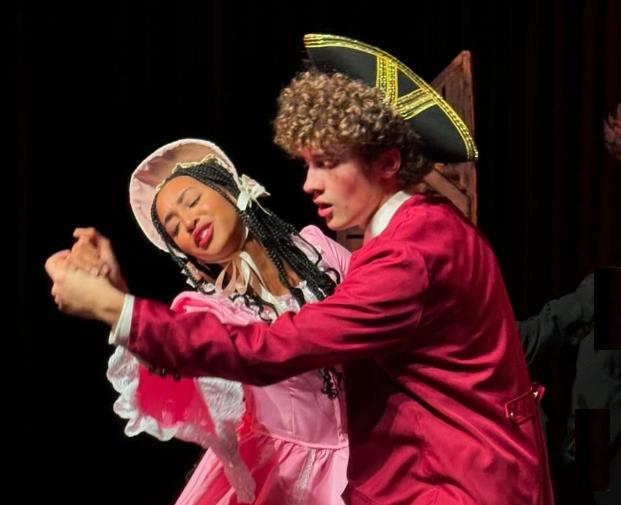
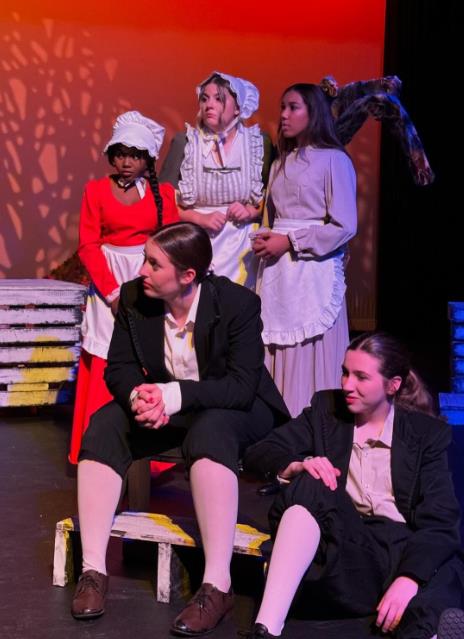

ArtReach's The
Legend of Sleepy Hollow - Norcross High School, GA
3.
The town the play is set in is called "Tarry Town" which
is based on a real village in New York called Tarrytown, about 30
miles north of New York City. The high school in Tarrytown's teams
are called 'The Horsemen'.
4.
There is a town in Illinois called Sleepy Hollow. Many of the town's
street names reflect that of the tale and the image of the Headless
Horseman is found on town publications and city landmarks.
5.
What Really Happens to Ichabod Crane? One of the mysteries of SLEEPY
HOLLOW is trying to guess exactly what happens to Ichabod at the end
of the story. It's fun to compare your ideas with other
students. Write down what YOU think happens to him!

Let's
Have Fun with Alice
in Wonderland!
Classroom
Discussions, Questions and Quotes
1. Why is the White
Rabbit in such a hurry? Where is he going?
2. What makes Alice
shrink? What makes her grow?
3. Why can't Alice get
through the door after she opens it with the key?
4. Why is
"Cheshire" pronounced "Cheshur"? Where was Lewis
Carroll from?
5. Why is the Queen
called the "Queen of Hearts"? What other three similar
Queens are there? What about the King and Jack and all the other "cards"?
"What
makes Alice shrink? What makes her grow?"

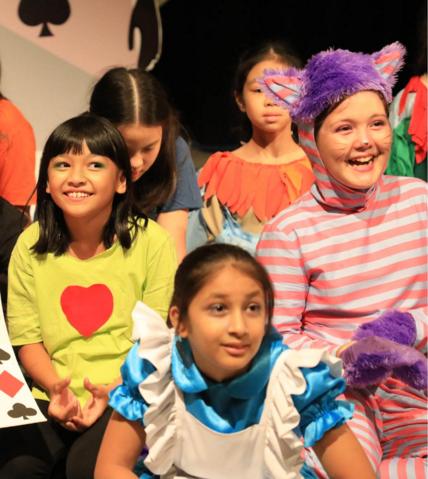
ArtReach's Alice
in Wonderland - Bangkok Patana School, Thailand
6. Why use Flamingoes
for croquet mallets? What color are Flamingoes?
7. Alice wakes up at the
end of the play. Was Wonderland a real place or was it only a little
girl's dream?
8. Why is Lewis Carroll
also called Charles Dodgson? What is a pseudonym?
"Was
Wonderland a real place or only a girl's dream?"
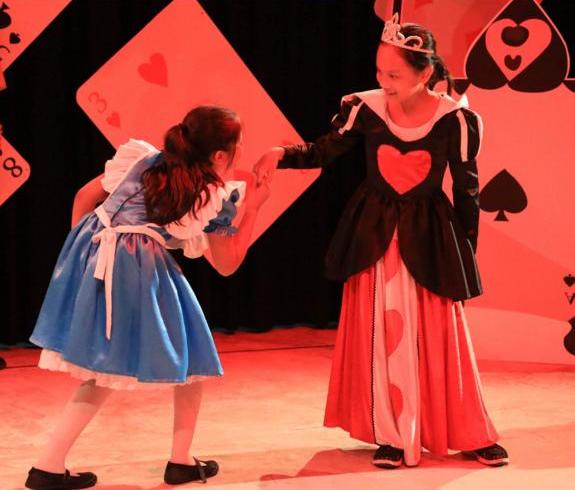
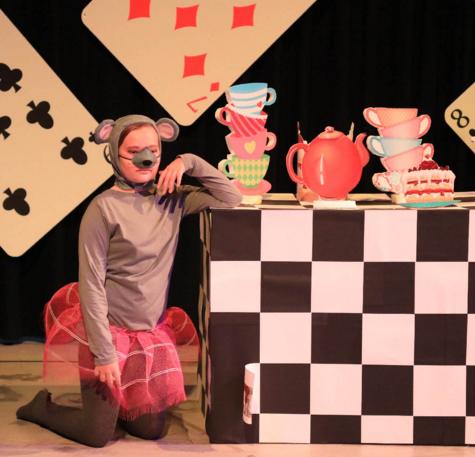
ArtReach's Alice in Wonderland
- Bangkok Patana School, Thailand
Famous Alice
in Wonderland Quotes:
Discuss what meaning these
sayings have for us in our everyday lives. Can you give an example
that illustrates the meaning or image?
"What is the use of a
book without pictures or conversations?" - Alice
"Curiouser and curiouser!"
- Alice
"Good-bye, hello,
good-bye, hello." - White Rabbit
"Shall I never get any
older than I am now? That'll be a comfort, one way -- never to be an
old woman -- but then -- always to have lessons to learn!" - Alice
"Well, then you see, a
dog growls when it's angry, and wags its tail when it's pleased. Now
I growl when I'm pleased, and wag my tail when I'm angry.
Therefore I'm mad."
- Cheshire Cat
"I can't explain
myself, I'm afraid, Sir, because I'm not myself you see." - Alice
"I've had nothing yet,
so I can't take more." - Alice
"You mean you can't
take less, it's very easy to take more than nothing." - Hatter
"Sentence first --
verdict afterwards!" - Queen
"Begin at the
beginning and go on till you come to the end: then stop." - King
"What
is the use of a book without pictures?"

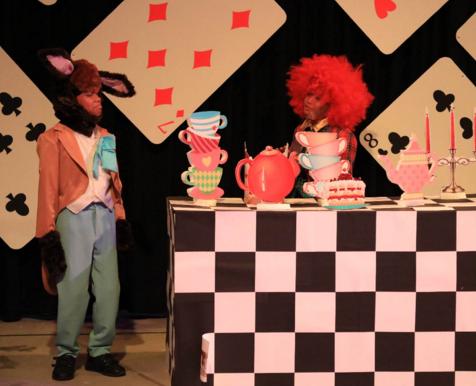
ArtReach's Alice
in Wonderland - Bangkok Patana School, Thailand

Lexington
Children's Theatre - Amelia Earhart
Here's
an Excerpt
from an Excellent
Study Guide for Amelia
Earhart Productions
Founded
in 1938, Lexington Children's Theatre, "the gem of
Lexington", is a professional theatre creating captivating
theatrical experiences for young audiences and is proud to be the
official Children's Theatre of the Commonwealth of Kentucky.
This awesome company has performed ArtReach Plays and plays by author
Kathryn Schultz Miller for many years.
See
the complete LCT study guide here: https://www.lctonstage.org/wp-content/uploads/2018/09/Amelia-Earhart-Play-Guide.pdf
"Lady
Lindy" is an American Hero
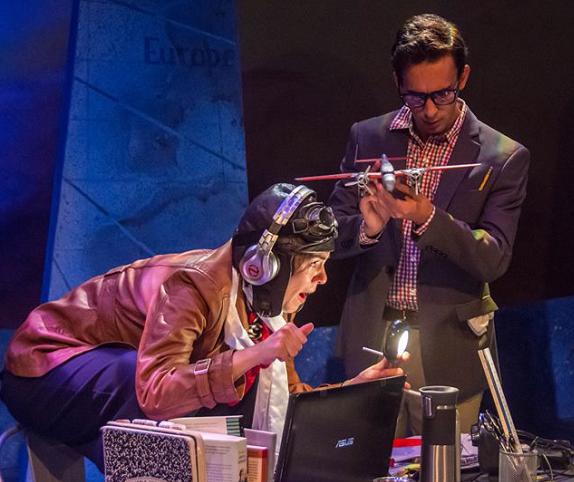
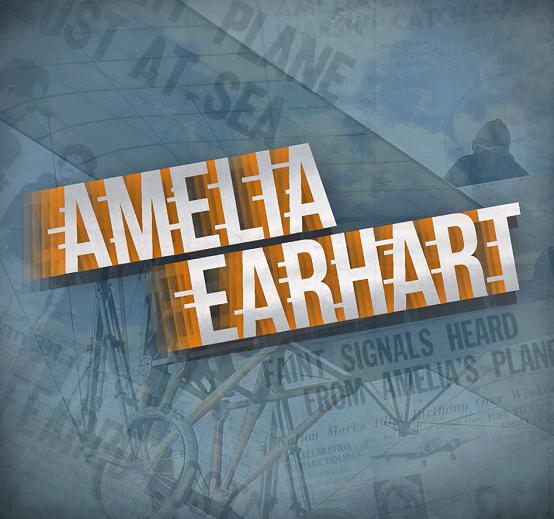
Amelia Earhart, Lexington
Children's Theatre, KY, professional production
Amelia
True or False:
Write
T if the statement is true and F if the statement is false.
1.
____ Amelia
Earhart was married to Charles Lindbergh.
2.
____ The first time Amelia Earhart flew across the Atlantic, she was
a passenger.
3.
____ Before she was a famous pilot, Amelia Earhart was a social worker.
4.
____ George Putnam was a Hollywood stuntman.
5.
____ The press referred to Amelia Earhart as "Lady Lindy."
6.
____ Amelia Earhart eventually married George Putnam.
7.
____ Paul Mantz taught Amelia all about the Lockheed Model 10E
Electra airplane.
"Captivating
theatrical experience for young audiences."
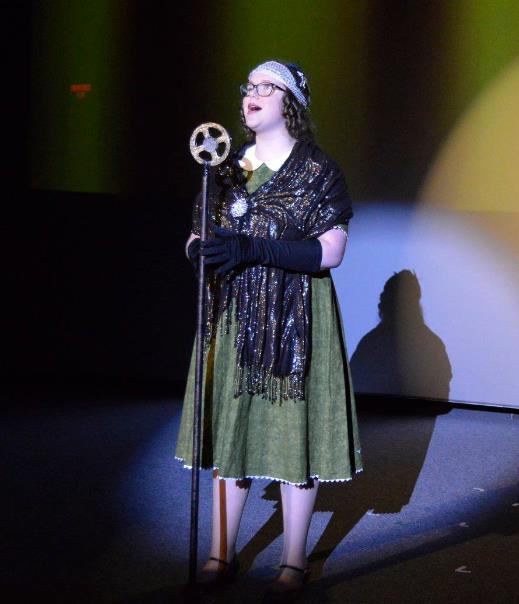
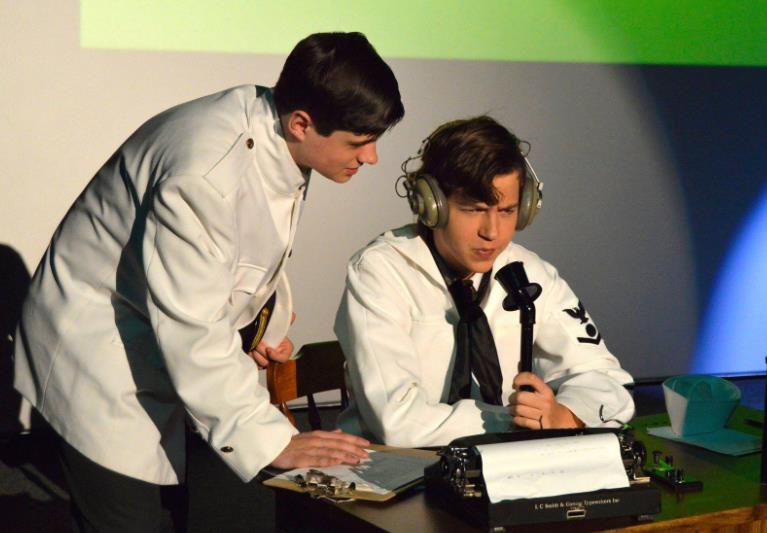
ArtReach's Amelia
Earhart - Air Zoo Aerospace & Science Center, Portage, MI
8.
____ Commander Thompson's ship was the U.S.S. Arizona.
9.
____ Amelia Earhart made her last flight alone.
10.
____ Amelia was trying to land on the island of Howland when she disappeared.
11.
____ Amelia Earhart disappeared on July 2, 1937.
13.
____ Amelia once landed in a cow pasture owned by a farmer named Gallagher.
14.
____ There are many theories, but no one knows for sure what
happened to Amelia.
"Goal
fulfillment and positive character traits."
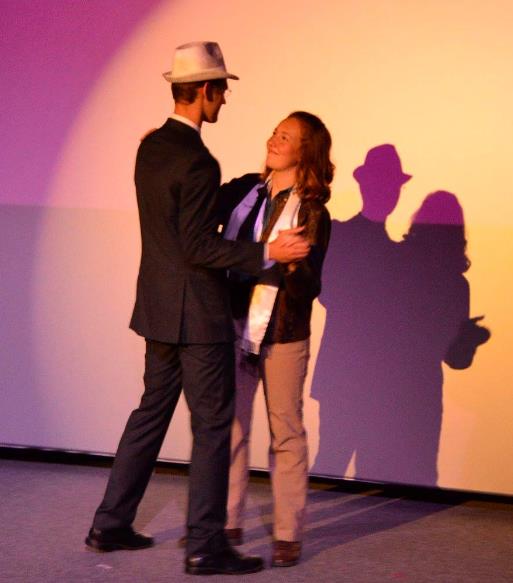

ArtReach's Amelia
Earhart - Air Zoo Aerospace Center, Portage, MI
Amelia
Discussion Questions:
Mention
some important events that occurred in Earhart's lifetime and
discuss one event in greater detail.
Why
do Amelia Earhart's contributions make her an important American hero?
What
were some of Earhart's significant challenges? What character traits
did she display in meeting these challenges?
Discuss,
in your own words, an understanding of the structure of a news story.
Discuss,
in your own words, an understanding of the relationship between goal
fulfillment and positive character traits.

SECRETS
OF THE IMPERIAL DRAGON ROBES
History
Info for
Classroom Discussion, ArtReach's The
Legend of Mulan
An
old Chinese proverb says that the reign of every emperor starts when
he dons his new robes. The imperial robes of the last Qing Dynasty
(1644-1911) lend legitimacy to this proverb. Clothing was seen as a
status symbol for many dynasties, and was the mark of an individual's
position in society.
"Dragons
symbolize importance, power and strength."
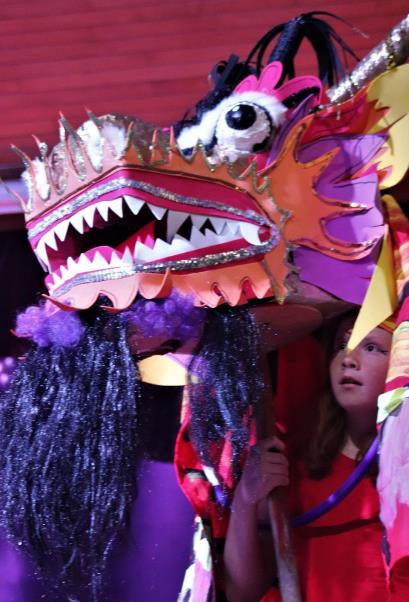
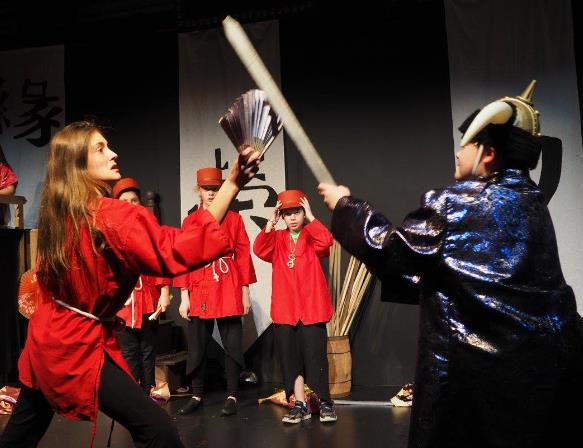

ArtReach's The
Legend of Mulan - Spotlight Studios, Fairport NY
For
example, the fur of a black fox and the color yellow were reserved
for high level officials and members of the imperial family. The
general public was not allowed to wear or even possess such clothes,
although they were allowed to sell them. Anyone found to violate this
rule was subject to harsh punishment, even the death penalty.
Dragons
symbolize importance, power and strength, represent all things male,
and were the symbol of the Emperor of China (who was said to sit on
the dragon throne). The imperial dragon is shown with 5 claws instead
of the usual 3-4, to distinguish him from lesser beasts.
"The
Emperor of China sat on the dragon throne."
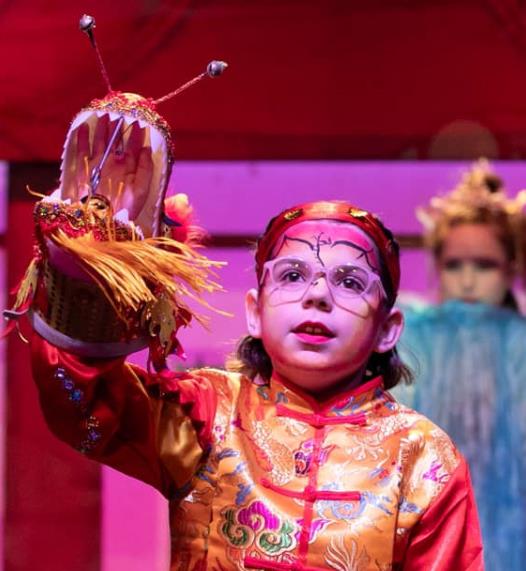

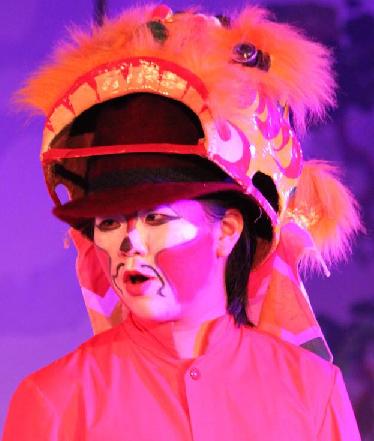
ArtReach's The
Legend of Mulan - Spotlight Studios, Fairport NY
The
anatomy of a Chinese dragon: The head of a camel, the horns of
a stag (male deer), the eyes of a demon, the ears of a cow, the neck
of a snake, the belly of a clam, the scales of a carp, the claws of
an eagle, the paws of a tiger.

What
is a Nutcracker? How did
it Become a Christmas Symbol?
Discussion for
ArtReach's "The
Nutcracker Prince"
A
nutcracker is a kitchen tool used to crack nuts, typically
consisting of two hinged metal levers between which the nut is
squeezed. The tool is designed to crack open all sorts of nuts, and
usually resembles a pair of pliers. Unlike pliers, the pivot point is
located at the end beyond the nut, rather than in the middle. The
spring-jointed nutcracker was invented by Henry Quackenbush in 1913.
Nutcrackers are also sometimes used for cracking the shells of crab
and lobster to reveal the meat inside.
"Nutcrackers
come in the forms of a soldier, knight, king."


Let Your Light Shine Youth
Theatre, Columbia MO - ArtReach's
The Nutcracker Prince
Modern
Nutcrackers: Nutcrackers
in the form of wooden carvings of a soldier, knight, king, or other
profession date back to the 15th century. The nutcrackers resemble
people with large mouths which the operator opens by lifting a lever
in the back of the figurine. (One could originally insert a nut into
the mouth, press down and crack the nut.) Modern nutcrackers of this
type serve mostly as decoration, mainly at Christmas time. Wooden
nutcrackers have become popular in the United States.
The
handcrafted wooden nutcrackers are a sought-after collector's item.
The "Bavarian village" of Leavenworth, Washington features
a nutcracker museum. Many other materials also serve to make
decorated nutcrackers, such as porcelain, silver, and brass; the
museum displays samples. Carvings by famous names like Junghanel,
Klaus Mertens, Karl, Olaf Kolbe, Petersen. The Christian
Ulbricht and especially the Steinbach nutcrackers have become
collectors' items.
"In
German folklore, nutcrackers bring good luck."
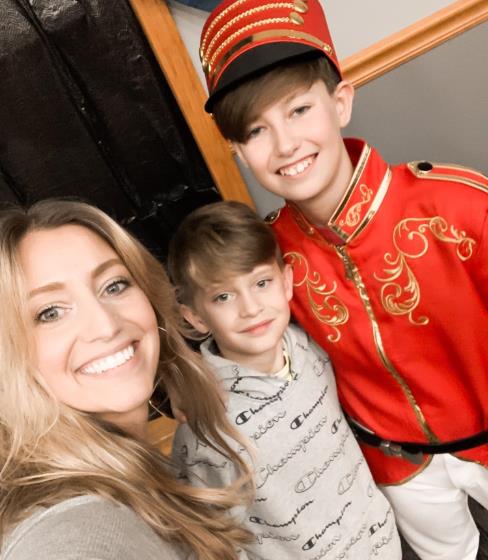
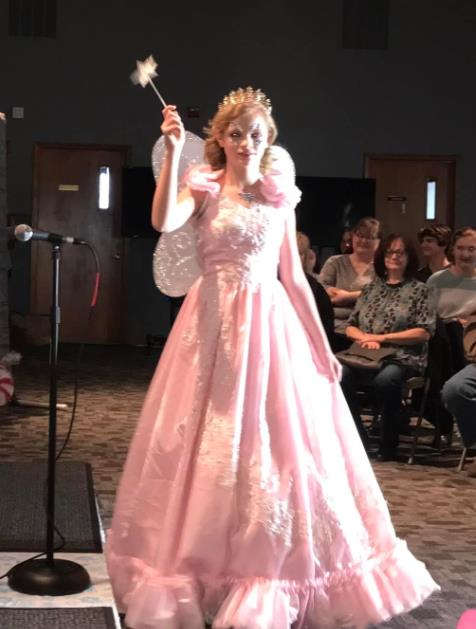

Let Your Light Shine Youth
Theatre, Columbia MO - ArtReach's
The Nutcracker Prince
Steinbach
Nutcrackers: Originating
as a cottage industry in the rural areas of Germany, the carving of
nutcrackers has become widespread. The most popular and famous
nutcracker carvings come from Sonneberg in Thuringia and form the Ore
Mountains. The most famous carvings came from Steinbach. He is also
known as the "King of Nutcrackers," as he started the
tradition of handcrafting and carving nutcrackers. The Steinbach name
is recognized throughout the world for the unique design of the
wood-carved Steinbach creations.
Good
Luck Symbols:
According to German folklore, nutcrackers bring good luck to your
family and protect your home. A nutcracker is said to represent power
and strength, serving somewhat like a watchdog guarding your family
against danger. A nutcracker bares its teeth to evil spirits and
serves as a messenger of good luck and goodwill. Long ago, rare or
unusual nutcrackers were part of the social dining tradition. Serving
as whimsical conversation pieces, guests lingered at the table
enjoying shelled treats such as pecans and hazelnuts.
"The
Nutcracker comes to life at the stroke of midnight."
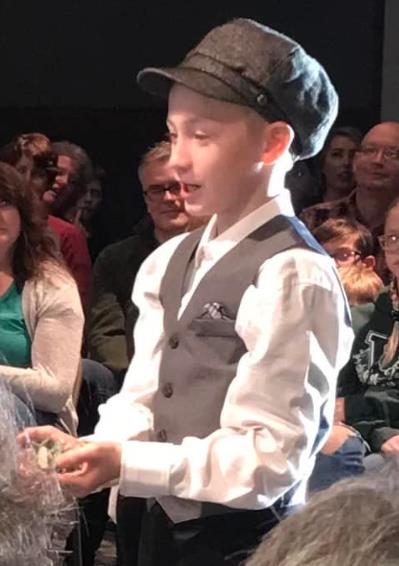

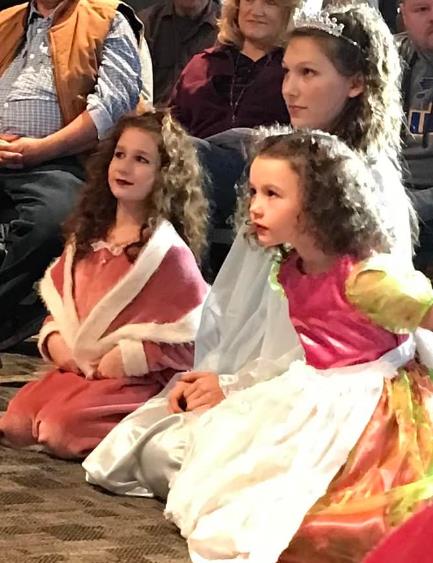
Let Your Light Shine Youth
Theatre, Columbia MO - ArtReach's
The Nutcracker Prince
The
Nutcracker Ballet: The
Nutcracker Ballet greatly popularized the nutcracker. When the
Christmas holiday ballet became popular in the United States in the
early 1950s, demand for nutcrackers increased tremendously.
Today,
many people collect themed nutcrackers, displaying them during the
holidays or even throughout the year. However, the most popular
nutcracker remains the wooden nutcracker doll presented as a
Christmas gift to Clara. Dressed as a soldier, it is broken by
Clara's jealous brother, Fritz. It is gently tucked under the
Christmas tree on Christmas Eve, coming to life at the stroke of midnight.

ArtReach's
Wizard of
Oz, Synopsis
Frank
L Baum's book comes to life on stage, kids perform!
The
Wizard of Oz is the
story that started it all. It begins when a little Kansas farm girl,
Dorothy Gale, and her dog Toto are blown away in a tornado and land
in a fairyland named Oz. Here she meets a very unusual cast of
characters - the Scarecrow, Tin Woodman, and Cowardly Lion, and
together they go on a quest to see the Wizard of Oz, each of them
seeking what they want most in life. Making their way along the
Yellow Brick Road through a series of hair-raising encounters, they
arrive at the Emerald City only to be told by the Wizard that they
first must kill the Wicked Witch of the West before he will grant
their wishes.
"Each
of them seeks what they want most in life."

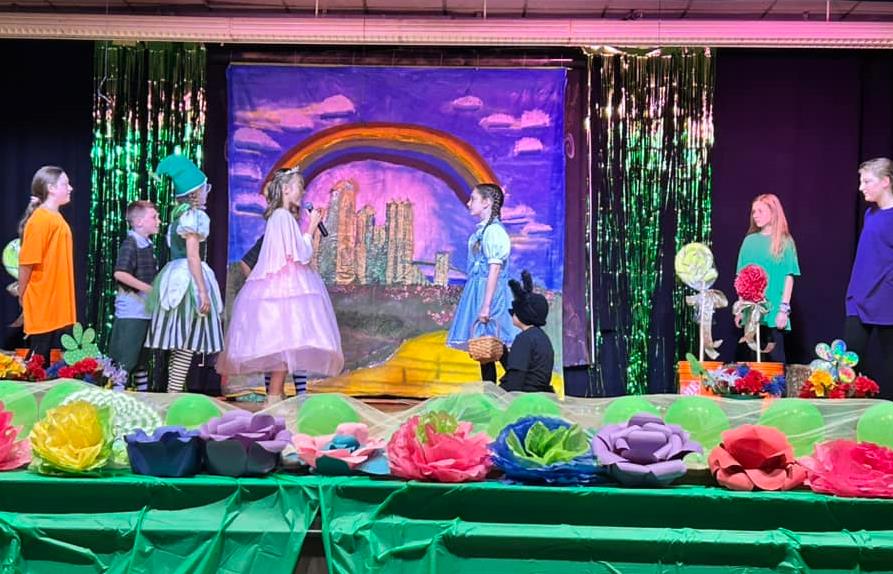
Glenbrook Elementary School,
Shelburne, ON - Tussing Elem, Colonial Heights VA
They
eventually overcome many dangerous challenges and dispose of the
witch (although quite by accident), and return only to find that the
Wizard is really just a humbug. He craftily addresses everyone's wish
but Dorothy's, which is to return home to Kansas. So once more
Dorothy and her friends set out, this time to find the Good Witch of
the South. These last adventures end happily with Dorothy and Toto
returning home, thanks to something she had all along.<aml>

GLOSSARY
for ArtReach's Aladdin
Let's Learn New Words!
Voila!
Used to call attention, to express satisfaction or
approval, or to suggest an appearance as if by magic. Omar uses the
word expecting to see the Cave of Wonders.
Open
Sesame: A magical command. Sesame was believed to have
magicial powers, hence the famous call of 'Open Sesame' from the
folktale Ali Baba And The Forty Thieves. This belief probably stemmed
from the startling tendency of the seedpods to burst open suddenly
with a sharp pop. Its long seed capsules burst open when they are
dry, scattering the seeds. Aladdin uses the words to open doors of
the Cave of Wonders.
Chinese
Silk: Animal fiber produced by certain insects as
building material for cocoons and webs. Silk has set the standard in
luxury fabrics for centuries. The origins of silk date back to
Ancient China. Legend has it that a Chinese princess was sipping tea
in her garden when a silkworm cocoon fell into her cup, and the hot
tea loosened the long strand of silk. Silk is sold in the market in "Aladdin".
Turkish
Rugs: Any of a large variety of hand woven rugs
produced in Turkey, characterized by coarse, heavy yarn and a long,
uneven pile - also called Turkish carpet. Turkish rugs are sold in
the market in our Aladdin play.
"A
Genie is
a
fabulous spirit with
special powers."
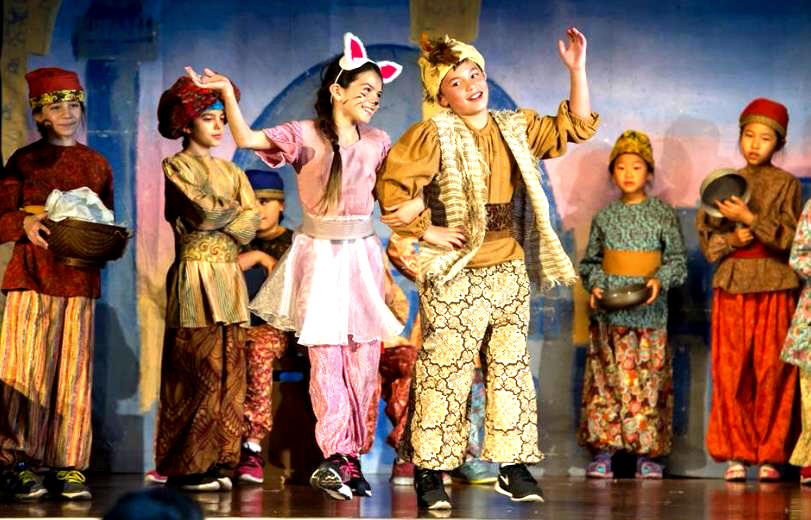
Palo Alto Children's Theatre,
CA - ArtReach's Aladdin
Incense:
Anaromatic gum or other substance producing a sweet odor when burned,
used in religious ceremonies, to enhance a mood, etc. Incense is sold
in the market in "Aladdin".
Genie:
A fabulous spirit having special powers, often
appearing in human form, which, when summoned by a person, is
required to perform the commands of the summoner. It is based on the
mythological "jinnee" -- the prototype is the genie
residing in an oil lamp, summoned by Aladdin.
Shooting
star: A starlike, luminous meteor, that, appearing
suddenly, darts quickly across some portion of the sky, and then as
suddenly disappears, leaving sometimes, for a few seconds, a luminous
train. Ginger points out a shooting star during her magic carpet ride.
"Euphrates
River is famed for its magnificence and culture."

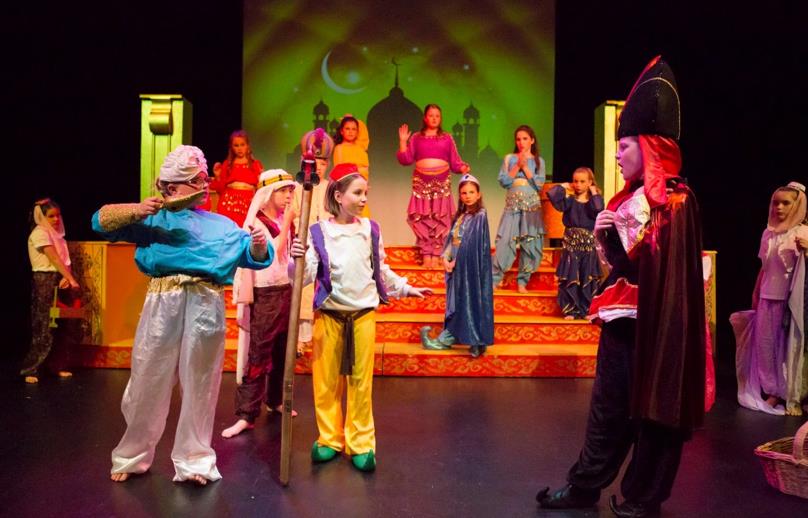
ArtReach's Aladdin
- Just Imagine Youth Drama School, Tasmania AU
Couscous:
The staple product of North Africa and the national
dish of the countries of Algeria, Morocco, and Tunisia. Couscous is
an icon also because it permits the expression of national identities
and ways of life, and it has religious and symbolic meanings. Women
usually prepare the grain known as couscous during a family
celebration, and the dish named couscous is eaten during a family feast.
Geewiz mentions
this food when talking to the Magician.
Babylon:
An ancient city of SW Asia, on the Euphrates River,
famed for its magnificence and culture: capital of Babylonia and
later of the Chaldean empire. Babylon is the name of the baby fish in "Aladdin".
Education
and Outreach Tour 2013-2014 Presents A
Thousand Cranes
By Kathryn
Schultz Miller, A Teacher's Guide: PCPA's Outreach Tour is funded in
part through grants from a number of gracious organizations. Thank
you to our generous sponsors: PXP * Target * Nichols Foundation
* The Towbes Foundation * Santa Barbara Foundation * Santa Maria Arts
Council * ERG * The Children's Creative Project *
1. Ancestors, family,
and tradition are all important qualities for the Sasaki family.
What are some of the traditions that you have in your family?
2. Sadako's family performs a
variety of rituals: taking off shoes before entering the house,
preparing sushi, bowing to others to show respect, and the
celebration of Obon. What rituals does your family
perform? What are some rituals that are carried out in your classroom?
"Why
is it important to be hopeful?"


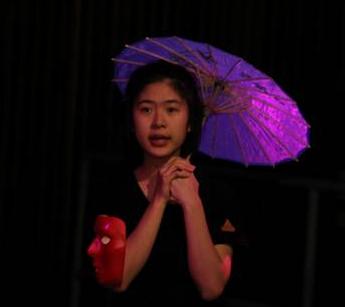
ArtReach's A
Thousand Cranes, Marianapolis Prep School, Thompson CT
3. Sadako loves to run
and practices very hard. It is very important to Sadako to
practice and have discipline. What is something that you love
to do that requires hard work and discipline?
4. The play takes place
in Japan in 1955, 10 years after the atomic bomb was dropped on
Hiroshima. What were the events that led up to the bombing of
Hiroshima and Nagasaki? Do you think the United States did the
right thing by dropping the bomb? How many atomic bombs have
been dropped since the end of WWII?
5. What does the crane
symbolize in Japanese culture? Why is it so important to Sadako?
6. Sadako remains
hopeful throughout the play, even towards the end of her life.
What does it mean to be hopeful? When have you demonstrated
hopefulness, even in the midst of a discouraging, or even hopeless
situation? Why is it important to be hopeful?
7. Sadako inspired
people across the world to strive for peace. At the base of the
statue of Sadako reads, "This is our cry. This is our
prayer. Peace in the world." What does peace mean to
you? What are some ways you can help to bring peace to our world?
"What
would your wish be?"


ArtReach's A
Thousand Cranes, Marianapolis Prep School, Thompson CT
8. Sadako is diagnosed
with Leukemia. What is Leukemia? How is it treated?
Why is it referred to in the play as "radiation sickness."
9. Kenji reminds Sadako
of the legend of the thousand cranes. If you were to become ill
and to build a thousand cranes, what would your wish be?
10. Many people
were affected by the bombing of Hiroshima. Grandmother shows
Sadako other spirits who tell about how they were affected.
What other events in history caused by humans, have affected numerous
lives? Why did these events happen? How have you been
affected by any such event?
The
True Story of Sadako
Classroom
History Information
See
more at: Kids Peace Station https://www.pcf.city.hiroshima.jp/frame/kids_e/sadako_e/sadako_18.html
The
Sasakis of the Sasaki Barbershop have a baby. Barely
into the new year of 1943, the Sasakis of the Sasaki Barbershop had a
baby girl in the middle of the night on January 7. One of the
Sasaki Barbershop's customers was an expert on telling fortunes based
on names. Wanting their little girl to grow up healthy and strong,
the Sasakis asked the naming expert to pick a name for their child.
He picked "Sadako." The war changes everyone's lives.
"A
blinding flash, then a thunderous blast."
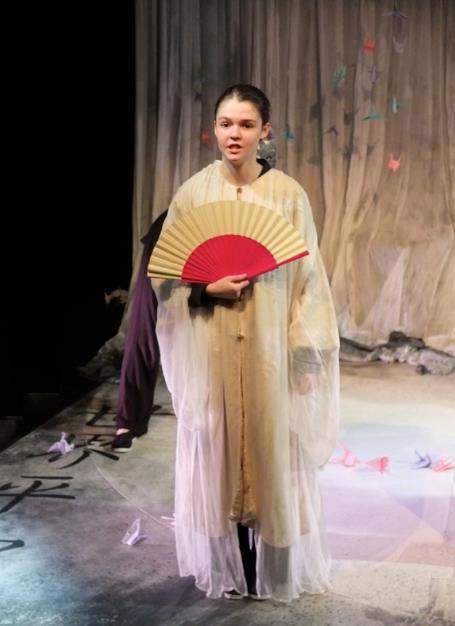

ArtReach's A
Thousand Cranes - Nottingham Playhouse, Neville UK
The
lives of the people became tougher as the war dragged on. The year
Sadako was born, her father was drafted into the military. He was
assigned to be a medic who nursed sick or injured soldiers at the
Army Hospital in Hiroshima. While he was gone, Sadako's mother
got relatives to help her keep the barbershop running. August 6,
1945: The world's first atomic bomb detonated in the sky over Hiroshima.
Sadako's
family also experienced the bombing. Around 1945, American
planes were flying over Japan dropping bombs on cities. These were
air raids. American planes sometimes flew over Hiroshima, setting off
sirens and sending people fleeing to air-raid shelters. On the
morning of August 6, air-raid sirens sounded just after 7:00 a.m.
After a while, the all-clear sounded, and people began to move about
their daily lives again. Sadako, her grandmother, her mother, and
brother Masahiro were eating breakfast together.
A
blinding flash, then a thunderous blast attacked the family. Black
Rain. The walls of the house toppled, and Sadako and the others were
thrown. Masahiro and grandmother were injured but, miraculously,
Sadako and her mother were unharmed. Somehow, all escaped from the
collapsed house and fled toward the river. Along the way, Sadako's
grandmother turned back to get something from the house. She was
never seen again.
"Sadako
was a healthy, energetic child."
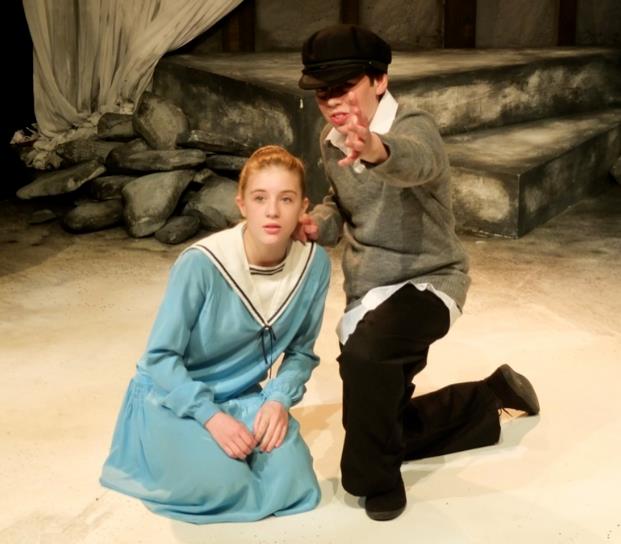

ArtReach's A
Thousand Cranes - Nottingham Playhouse, Neville UK
Fires
were igniting here and there. Someone helped the family into a
small, decrepit boat to save them from the fires. Though only four at
the time, Masahiro remembers desperately bailing water. While
the family was on the boat, rain began to fall. The rain left black
splotches on Sadako's clothes.
Sadako's
grandmother dies. For the past month, the Army Hospital
patients and staff, including Father Shigeo, had been evacuated to
Miyoshi City in north Hiroshima Prefecture. After the bombing, Shigeo
returned to Hiroshima as a rescue squad member, erecting tents and
helping the injured. On the 9th, Shigeo finally had the chance to
return to his burned home, where he learned that his mother was
dead. 1949-1954: Though an atomic bombing survivor, Sadako was
a healthy, energetic child who never missed a day of elementary
school due to illness. She was a gentle caretaker of her younger
sister and brother. She loved singing and sport-in fact, Sadako could
outrun anyone in her class.
The
war ended. Gradually, buildings were erected and people returned to
the city where the rumor had spread that "nothing will grow for
75 years." The Sasaki family reopened their barbershop in the
heart of Hiroshima. Soon, her younger sister Mitsue was born. The
year after Sadako started in Nobori-cho Elementary School, her
younger brother Eiji was born. The Sasaki family now had six members.
With the parents busy running the barbershop, keeping the house clean
and taking care of the little ones fell to Sadako and Masahiro. It
was common for children to help with housework in those days.
Everyone in the family pitched in to do what needed to be done.
Working together, Sadako's class wins the relay!
"1,000
paper cranes were folded by high school students."


ArtReach's A
Thousand Cranes - Nottingham Playhouse, Neville UK
Sadako
was an exceptional athlete in her class. During the
class relay on the spring Field Day, because Sadako's Bamboo class
fumbled the baton pass, the Bamboos came in last place for the entire
sixth grade. The Bamboos decided to practice relay racing every day
after school. The fleet-footed Sadako shone at these practices. Even
the fastest boys could not keep up with her. Thanks to those
practices, when the fall Field Day came, the Bamboos easily outran
every other class and claimed the victory. 1955: Ten years after the
atomic bombing, life returned to normal for Hiroshima City and its
people. However, something was wrong with Sadako's body.
Soon
after winning the relay on Field Day, there were signs that
something was wrong with Sadako. She caught a cold and felt a
stiffness in her neck. When the cold went away, the stiffness stayed.
By early 1955, Sadako's face looked swollen. o After undergoing
various tests, the doctor told Shigeo in February, "Sadako has
leukemia. She has a year to live, at the most." Sadako was
admitted to the Hiroshima Red Cross Hospital. Hearing the news,
Sadako's friends in the Bamboo class discussed what they could do to
help Sadako. They decided to take turns visiting her in the hospital.
Entrusting her Hopes to Paper Cranes.
Around
five months after Sadako was hospitalized, a five-year-old girl in
her hospital died from leukemia. "I wonder if I'm going to die
like that," she said simply. Sadako evidently knew that she had
leukemia and what a frightening disease it was. At age 12, Sadako
battled the terror of death. In August, 1,000 paper cranes folded by
high school students in Nagoya were delivered to the patients in the
hospital. Sadako's room, too, was brightened by cellophane cranes
folded in many colors.
Receiving
those cranes and hearing the legend, "Fold 1,000 paper cranes
and your wish will come true," Sadako began to fold paper cranes
herself. She threw herself into the task, folding into each crane the
desire: "Let me get well."
The
candle of Sadako's life is blown out. Sadako never talked about her
pain or suffering. She simply folded her prayers into the paper
cranes. Despite her efforts, the disease progressed. She began to get
fevers, and some days her pounding head kept her from sleeping. Even
then, she folded cranes fervently. o In the morning of October 25,
Sadako's life finally ended. She was 12 years old. It was exactly a
year since the Bamboo class had won the relay on Field Day.
1956: Sadako's death came as a tremendous shock to the members of the
Bamboo class. Many of them, like Sadako, had experienced the atomic
bombing. They were filled with fear, regret, and a sense of helplessness.
"The
statue was completed on Children's Day."
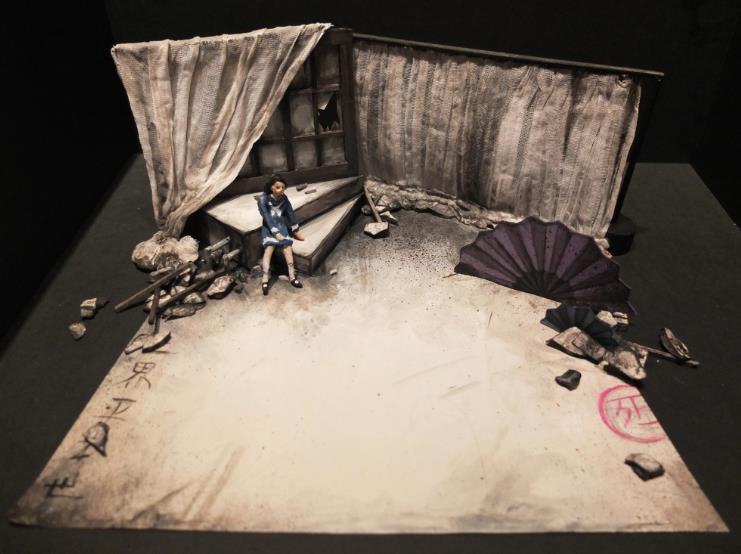
ArtReach's A
Thousand Cranes - Nottingham Playhouse, Neville UK
After
Sadako died, her Bamboo classmates said to each other, "Let's
do something for Sadako." That they, her friends, were able to
do nothing for her left a painful feeling in their hearts. Someone
said, "Can we erect a gravestone for her? If it is nearby, we
can visit it every day." Sadako's classmates take action. o
"What if we make a monument in Peace Memorial Park? Not just for
Sadako, but for all the children who died from the atomic bomb."
"Do
we have what it takes to do something like that?" The students
were worried. "But I really want to do something for
Sadako." "I want to get rid of atomic bombs." These
were the emotions that moved the group to action. Children around
Japan cooperate with the movement. Sadako's former Bamboo classmates
began a movement to raise funds for a monument. Their call elicited a
huge response that they had not anticipated. More than 3,000 schools
around Japan sent money and letters saying, "Please use this to
help build the monument." In January 1957, it was officially
decided to build the Children's Peace Monument in Peace Memorial Park.
The
statue was completed on Children's Day (May 5) in 1958, two years
after Sadako Sasaki's death. Though Sadako and the other
children who had passed away would not return, the inscription carved
into the stone in front of the monument at least carried the hope,
"Let no more children fall victim to an atomic bombing."
This
is our cry. This is our prayer. Peace in the world.

Lets
Talk About Peter Pan!
Get
Your Cast and Class Ready With Discussion on Peter
Pan!
Discussion
/ Questions: Have a class discussion about what it would be
like to never grow up and to live in an imaginary – make-believe
– place like Neverland:
What would
happen if you never grew up, never got older?
(You’d
be in this same class forever! No more birthdays! Nor birthday
presents! Your friends would get older, graduate, go away, you’d
still be a kid! Etc., etc. This can be fun.)
Why do you
think Peter Pan never wanted to grow up?
(On the
day he was born his parents told him all the things he would have to
do when he grew up – so he ran away from home! Now, that’s
pretty imaginative!)
"What
would happen if you never grew up, never got older?"

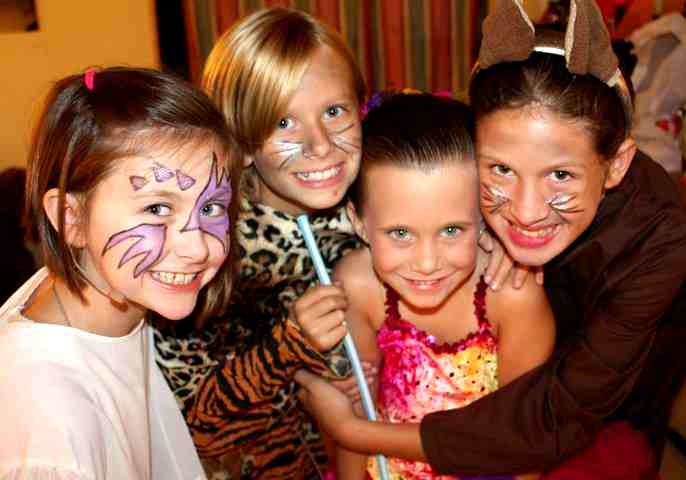
Turkey Hill
School, Orange, CT -- Whole Backstage Theatre, Guntersville, AL
Do you
think there’s actually a magical place like Neverland?
(There
was for Peter Pan! Neverland is an imaginary place created by the man
who wrote the story, J. M. Barrie. Even Peter Pan and all the people
in the story are imaginary. But isn’t imagination a wonderful
thing? Without it we wouldn’t have wonderful stories like Peter
Pan, the Wizard of Oz, Cinderella.)
Can you
think of your own magical place? What would you call it?
(Magicland?
Fantasyland? Funnyland? Weirdland? Billyland, Maryworld...)
Who would
live in your magic land?
(You?
Me? Pirates? Space people? Crocodiles? Dinosaurs? Green elephants?
Hump back camels and chimpanzees? Unicorns?)
Can you
really fly? But can you imagine what it would be like to fly?
"Can
you think of your own magical place?"
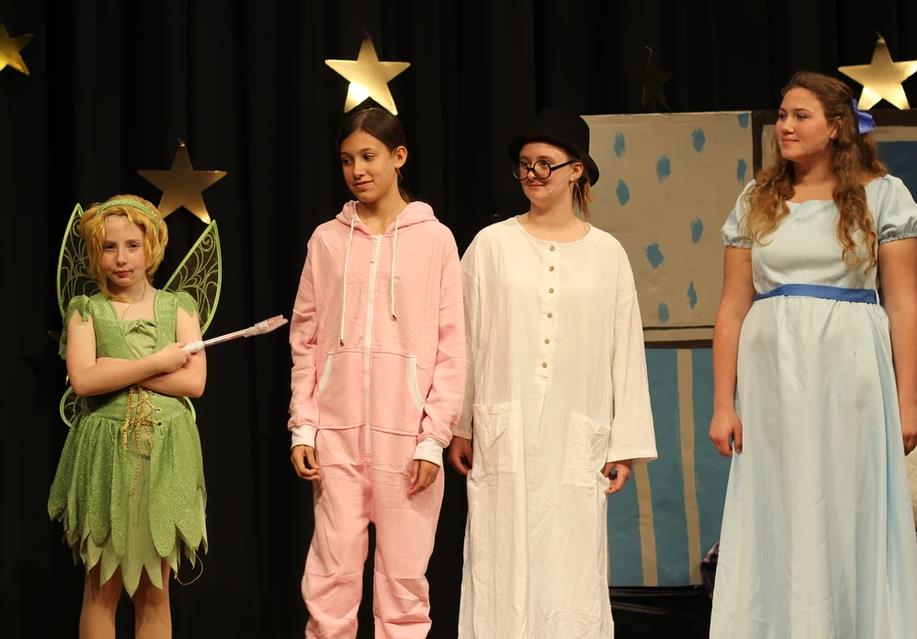
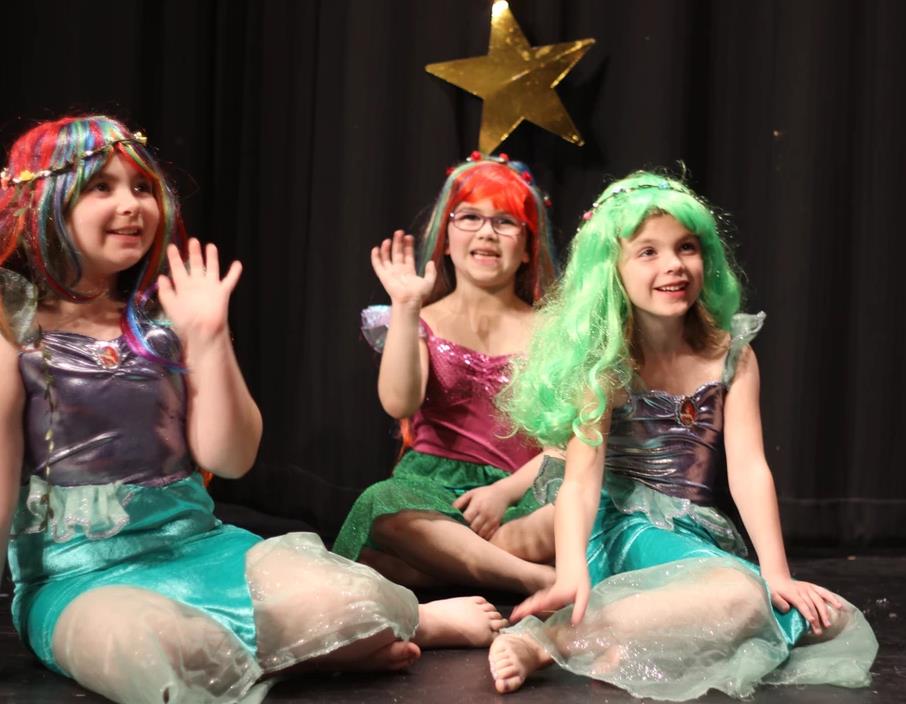
ArtReach's Peter
Pan - C-pac Theatre Company, Columbiana, OH
(Sometimes
the only way we can "do” something is to imagine doing
it.) (Continue the discussion...)
What would
it be like if we couldn’t imagine fun or silly or impossible things?
If we
couldn’t play? If we had to be serious and real all the time?
Even when
we get older we’ll still like to imagine fun things, won’t we?
So even
though we all have to get older, maybe we can be like Peter
Pan by using our imaginations to create a world where we
"never grow up” – like writing stories, painting
pictures, playing music...
Or
performing a play.
Fun
Learning with Creative Dramatics
with ArtReach's
Emperor's New Clothes
Pantomime!
Sculptures! Court of Animals!
Pantomime
Explain
pantomime to children as acting without words or props. It combines
elements of theater and works best with a strong script or actions
and allows the actors to "talk” without speaking. The
secret is to exaggerate everything and move in slow motion.
For simple
pantomime activities, pick kids and ask them to pretend they are
doing sports activities. The kids in the audience should try to guess
what the "actor” is doing. If possible, have enough
activities so that every child has an opportunity to pantomime.
Creating
Sculptures
Divide the
class into pairs. In each pair, one student is the
"sculptor" and one the "clay." The sculptor
"sculpts" his or her partner's body into a statue of his or
her choosing. The sculptor may do this by physically moving the
partner's body into position, or by showing the "clay" how
to stand. The sculptor pays close attention to even small details
like facial expression or the position of a finger.
When the
"sculpture" is finished, she or he freezes. (It the
position is difficult or impossible to hold, the "sculpture"
may memorized it and then relax until her or his turn in the
"tour" arrives.
Once all
of the artists have finished their masterpieces, I call them together
in the center of the room. The "sculptures" remain in place
around the room. In role as a museum guide, I conduct a tour of the
"gallery." When we reach each work, the artist who made it
steps forward and explains his or her work to the group. In this way
we make a complete tour, giving each artist a chance to show off and
describe his or her work.
Once a
"sculpture" has been viewed, she or he may relax and join
the group on the rest of the tour. Once the "tour" is
finished, the partners switch roles and the process is repeated.
ArtReach's
Play:
Fun
With Creative Dramatics!


Audience
Participates in the Emperor's Parade! Ensworth School,
Nashville, TN
Emperor’s
Court of Animals
Every good
Emperor, like a King, needs a court. A King needs to have people
around him who are his friends, whom he can trust and upon whom he
can rely. These people are called courtiers. What qualities should
courtiers possess? Some will suggest: "strong," and
"brave," "helpful" and "loyal," and
"clever." Think about which animals exemplify each quality.
(For example, elephants are strong and helpful, dogs are helpful and
brave, cats are clever and brave, horses are loyal and helpful, etc.)
Discuss
the sort of animals who would make good courtiers Appoint an
"Emperor” and call the animals forward. He asks, "What
sort of animal are you?" The student announces what animal he or
she is portraying. The student then describes the qualities of
her/his animal that make that court." After the animals have
been named have them have a "royal procession” with the
Emperor leading the animals around the room.
Cinderella
Party Games, Classoom Fun with ArtReach's
Cinderella
Creative
Dramatics Ideas for Teachers
Pass The Glass Slipper
- Play this game like Hot Potato: Turn your back to the guests
-seated in a circle - play music and whenever you stop the music the
person with the shoe is out - the last person left wins. (An
idea for making a glass slipper is to use one of your old high heels
and glue a bunch of glitter to it )
Pin The Star On
Fairy Godmother's Wand
- Print out or draw a picture of the fairy godmother without the star
on the end of her wand. Print out or draw enough stars for each guest
and play this like pin the tail on the donkey.
Students
play
"Pin the Star on Fairy Godmother's Wand"

Cinderella
Performance, Athol-Royalston School Theatre, WA
Who Am I
- Before the party, write the names of Cinderella characters on
several 3x5 cards; stepmother, step sisters, prince, fairy
godmother... To play, tape the cards onto the girls
backs, so that they cannot see their own character. The object of the
game is to identify who is on your back, by asking yes/no questions
of the other players. Example: Am I a girl ? Boy? Am I nice? Do
I have magical powers?
American
Sign Language, Learn with ArtReach's
Cinderella
A Great Way to
Enhance Your School's Performance!
How do you say
Merry Christmas in ASL?:
Take both
of your hands and put them on your chest by your collar bones and
extend them outwards twice. Then you make a C (if you don't
know how to sign spell then its exactly how you would imagine how a C
would be)... and you rest both your arms over each other (like in
"I dream of Jeannie") and lift up the arm with the C to a
90 degree angle.
American Sign
Language: It is becoming quite common to see a stage
production signed for the deaf community in the audience. This
not only makes the play accessible to more people it can add a
wonderful dramatic element for everyone. I once saw a
production of "The Secret Garden" signed in Scotland.
It was helpful to me because I often found the Scottish accent hard
to understand. But what made the experience memorable was that
the signer's reaction to the play. Near the climax the signer
was so moved by the performance that she was signing through
tears. She may have not been aware that her emotions made her
gestures more fluid and they became a kind of background music that
made the drama even more poignant.
American
Sign Language is Important Part of Performance
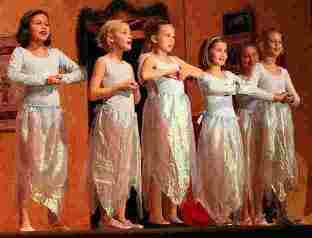
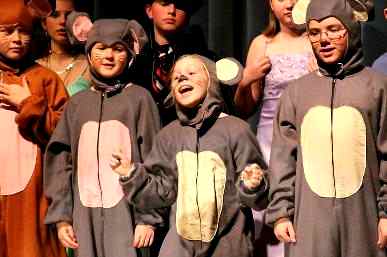
The Chorus
tells Cinderella's
Story! Theatre Works, LLC of Stewartstown, PA
Consider having your students
learn to sign a scene from the play. As many as ten or more
students may participate in this way and might spark an interest that
will become a lifelong skill. The Internet is an
excellent medium for learning American Sign Language since it can
incorporate short videos to illustrate gestures. Here
are some resources:
A Basic
Dictionary of ASL Terms: https://www.masterstech-home.com/aSLDict.html
Handspeak.com: https://www.handspeak.com/
Lesson Tutor: https://www.lessontutor.com/eesASLdictionarylinks.html
Start ASL.com: https://www.start-american-sign-language.com/asl-dictionary.html
Using American
Sign Language in the Classroom: https://www.brighthub.com/education/special/articles/5250.aspx
ArtReach's
Treasure Island: Yo-ho-ho and a Barrel of Fun!
Pirate Talk
& High Sea Terms in ArtReach
Stage Adaptation of Robert Louis Stevenson
Classic Adventure
Glossary: These
are nautical terms and pirate/sailor slang used by characters in the play.
Blimey: An English
expression of surprise or excitement.
Buccaneers: A term for
pirates, usually on the South American coast.
Scallywag: A pirate
expression for someone who is mischievous.
Land lubber: A pirate
expression for someone who is not used to being at sea.
Doubloons: A Spanish
gold coin, found in pirate treasures.
Rapier wit: A rapier is
a thin sword with a long point. If you say someone has a rapier wit
you mean they are very intelligent and clever.
Wench: A pirate type of
woman with a fiery attitude.